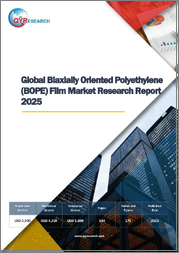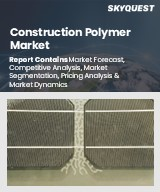
|
시장보고서
상품코드
1635887
에틸렌 흡수제 시장 보고서 : 제품별, 용도별, 최종사용자별, 지역별(2025-2033년)Ethylene Absorber Market Report by Product, Application, End User, and Region 2025-2033 |
||||||
에틸렌 흡수제 시장 세계 시장 규모는 2024년에 128억 달러에 달했습니다. 향후 IMARC Group은 2033년까지 시장 규모가 485억 달러에 달해 2025년부터 2033년까지 15.18%의 연평균 성장률(CAGR)을 기록할 것으로 예상하고 있습니다. 주거 분야의 수요 증가, 운송 중 과일과 채소의 품질과 영양을 유지해야 할 필요성 증가, 포장 산업의 번영 등이 시장을 주도하는 주요 요인입니다.
에틸렌 흡수제는 에틸렌 흡수 백, 에틸렌 필터, 흡수성 에틸렌 패드, 에틸렌 흡수 시트, 다양한 과일, 채소, 꽃의 성숙을 촉진하는 에틸렌 환경 제어 시스템으로 구성됩니다. 에틸렌 및 기타 휘발성 유기화합물(VOC)을 흡수하여 창고 내에서 식품을 천천히 숙성시킵니다. 사과, 키위, 살구, 바나나, 바나나, 망고, 오이, 토마토, 아보카도 등의 과일을 보관하는 데 사용되는 종이봉투나 골판지 운송용 포장에 적용할 수 있습니다. 또한 소매점이나 소비자에게 이익을 가져다주기 위해 소매용 제품 팩에 작은 봉지로 통합할 수도 있습니다. 또한 부패, 곰팡이, 변색, 시들음, 시들음, 연화, 화상, 질감 저하 등 에틸렌 가스가 유발하는 다양한 부작용을 방지할 수 있습니다. 취급이 간편하고, 쉽게 구할 수 있으며, 비용 효율성이 높기 때문에 에틸렌 흡수제에 대한 수요가 전 세계적으로 증가하고 있습니다.
에틸렌 흡수제 시장 동향:
현재 에틸렌은 모든 식물에서 생성되고 저농도에서도 과일과 채소의 숙성, 연화, 열화를 유발하기 때문에 에틸렌 흡수제에 대한 수요가 증가하고 있으며, 이는 시장 성장을 뒷받침하는 중요한 요인 중 하나입니다. 이 외에도 과망간산칼륨(KMnO4), 제올라이트, 활성탄, 경석 등 에틸렌을 제거하기 위해 패키지에 적절한 포집제를 포함하는 에틸렌 포집제에 대한 수요 증가는 시장에 긍정적인 영향을 미치고 있습니다. 또한, 망고, 사과, 키위, 바나나, 아보카도와 같은 과일의 유통기한을 연장하기 위해 전 세계적으로 에틸렌 흡수제의 사용이 증가하고 있습니다. 이와 더불어 브로콜리의 작은 꽃의 품질을 유지하기 위해 제올라이트를 함유한 저밀도 폴리에틸렌(LDPE) 백에 대한 수요가 증가하고 있는 것도 시장 성장을 촉진하고 있습니다. 또한, 식품의 급속한 열화로 인한 폐기물을 줄이기 위해 주택 부문에서 에틸렌 흡수제에 대한 수요가 증가하고 있는 것도 시장 전망을 좋게 만들고 있습니다. 이와는 별도로, 운송 중 과일과 채소의 품질과 영양을 유지하기 위해 에틸렌 흡수제의 사용이 증가하고 있습니다. 이는 번성하는 포장 산업과 결합하여 시장 성장을 강화하고 있습니다. 또한 전 세계적으로 수확 후 저장 용량이 증가하여 업계 투자자들에게 유리한 성장 기회를 제공하고 있습니다.
본 보고서에서 다루는 주요 질문
- 에틸렌 흡수제 시장 세계 시장 규모는?
- 2025-2033년 세계 에틸렌 흡수체 시장의 예상 성장률은?
- 세계 에틸렌 흡수제 시장을 주도하는 주요 요인은 무엇인가?
- COVID-19가 세계 에틸렌 흡수제 시장에 미치는 영향은?
- 세계 에틸렌 흡수체 시장의 제품별 시장 현황은?
- 세계 에틸렌 흡수제 시장의 용도별 시장 현황은?
- 세계 에틸렌 흡수제 시장의 주요 지역은?
- 세계 에틸렌 흡수체 시장의 주요 플레이어/기업은?
목차
제1장 서문
제2장 조사 범위와 조사 방법
- 조사 목적
- 이해관계자
- 데이터 소스
- 1차 정보
- 2차 정보
- 시장 추정
- 상향식 접근
- 하향식 접근
- 조사 방법
제3장 주요 요약
제4장 소개
- 개요
- 주요 업계 동향
제5장 세계의 에틸렌 흡수제 시장
- 시장 개요
- 시장 실적
- COVID-19의 영향
- 시장 예측
제6장 시장 내역 : 제품별
- 에틸렌 방지 백
- 시장 동향
- 시장 예측
- 에틸렌 필터
- 시장 동향
- 시장 예측
- 에틸렌 흡수 봉투
- 시장 동향
- 시장 예측
- 에틸렌 흡수 패드
- 시장 동향
- 시장 예측
- 에틸렌 흡수 시트
- 시장 동향
- 시장 예측
- 에틸렌 환경 제어 시스템
- 시장 동향
- 시장 예측
- 기타
- 시장 동향
- 시장 예측
제7장 시장 내역 : 용도별
- CA저장
- 시장 동향
- 시장 예측
- 숙성실
- 시장 동향
- 시장 예측
- 운송/배송
- 시장 동향
- 시장 예측
- 주택
- 시장 동향
- 시장 예측
제8장 시장 내역 : 최종사용자별
- 과일과 야채
- 시장 동향
- 시장 예측
- 꽃
- 시장 동향
- 시장 예측
- 작물과 종자
- 시장 동향
- 시장 예측
제9장 시장 내역 : 지역별
- 북미
- 미국
- 캐나다
- 아시아태평양
- 중국
- 일본
- 인도
- 한국
- 호주
- 인도네시아
- 기타
- 유럽
- 독일
- 프랑스
- 영국
- 이탈리아
- 스페인
- 러시아
- 기타
- 라틴아메리카
- 브라질
- 멕시코
- 기타
- 중동 및 아프리카
제10장 촉진요인, 억제요인, 기회
- 개요
- 성장 촉진요인
- 성장 억제요인
- 기회
제11장 밸류체인 분석
제12장 Porter's Five Forces 분석
- 개요
- 구매자의 교섭력
- 공급 기업의 교섭력
- 경쟁 정도
- 신규 참여업체의 위협
- 대체품의 위협
제13장 가격 분석
제14장 경쟁 구도
- 시장 구조
- 주요 기업
- 주요 기업 개요
- Bee Chems
- Bioconservacion SA
- BioXTEND Inc.
- DeltaTrak Inc.
- Ethylene Control Inc.
- Greenkeeper Iberia S.L.
- Keep-It-Fresh
- Lipmen Co. Ltd.
- Secco International Group
- Sercalia SL
- Symphony Environmental Ltd.(Symphony Environmental Technologies Plc)
The global ethylene absorber market size reached USD 12.8 Billion in 2024. Looking forward, IMARC Group expects the market to reach USD 48.5 Billion by 2033, exhibiting a growth rate (CAGR) of 15.18% during 2025-2033. The growing demand in the residential sector, increasing need to maintain the quality and nutrition of fruits and vegetables during transportation, and thriving packaging industry represent some of the key factors driving the market.
Ethylene absorber comprises ethylene absorbent bags, ethylene filters, absorbent ethylene pads, ethylene absorber sheet, and an ethylene environmental control system that accelerates the maturation of various fruits, vegetables, and flowers. It absorbs ethylene and other volatile organic compounds (VOC), which allow food products to mature more slowly in the warehouse. It can be embedded into paper bags or corrugated fiberboard transit packaging used for storing fruits, such as apples, kiwifruit, apricots, bananas, mangoes, cucumbers, tomatoes, and avocados. It can also be incorporated as sachets into retail packs of the products to benefit the retailer and consumers. It also prevents decay, mold, discoloration, wilting, softening, scald, loss of crunch, and many other negative effects caused by ethylene gas. As it is easy to handle, readily available, and cost-effective, the demand for ethylene absorber is rising across the globe.
Ethylene Absorber Market Trends:
At present, the increasing demand for ethylene absorbers as ethylene is produced by all plants and induces fruit and vegetable ripening, softening, and deterioration, even at low concentrations represents one of the key factors supporting the growth of the market. Besides this, the growing demand for ethylene scavengers that contains an appropriate scavenger in the package, such as potassium permanganate (KMnO4), zeolite, active carbon, and pumice, to remove ethylene is positively influencing the market. In addition, there is a rise in the utilization of ethylene absorbers to extend the shelf life of climacteric fruits, such as mangoes, apples, kiwis, bananas, and avocados, across the globe. This, along with the escalating demand for low density polyethylene (LDPE) bags comprising zeolite to maintain the quality of broccoli florets, is propelling the growth of the market. Moreover, the growing demand for ethylene absorbers in the residential sector to reduce the wastage of food due to its rapid deterioration is offering a favorable market outlook. Apart from this, there is an increase in the employment of ethylene absorbers to maintain the quality and nutrition of fruits and vegetables during transportation. This, coupled with the thriving packaging industry, is strengthening the growth of the market. Additionally, the rising post-harvest storage capacity around the world is offering lucrative growth opportunities to industry investors.
Key Market Segmentation:
Product Insights:
- Anti-Ethylene Bag
- Ethylene Filter
- Ethylene Sachet
- Ethylene Absorbent Pad
- Ethylene Absorbent Sheet
- Ethylene Environmental Control Systems
- Others
Application Insights:
- Controlled Atmosphere Storage
- Ripening Rooms
- Transportation/Shipping
- Residential
End User Insights:
- Fruits and Vegetables
- Flowers
- Crops and Seeds
Regional Insights:
- North America
- United States
- Canada
- Asia Pacific
- China
- Japan
- India
- South Korea
- Australia
- Indonesia
- Others
- Europe
- Germany
- France
- United Kingdom
- Italy
- Spain
- Russia
- Others
- Latin America
- Brazil
- Mexico
- Others
- Middle East and Africa
- The report has also provided a comprehensive analysis of all the major regional markets, which include North America (the United States and Canada); Asia Pacific (China, Japan, India, South Korea, Australia, Indonesia, and others); Europe (Germany, France, the United Kingdom, Italy, Spain, Russia, and others); Latin America (Brazil, Mexico, and others); and the Middle East and Africa.
Competitive Landscape:
- The report has also provided a comprehensive analysis of the competitive landscape in the global ethylene absorber market. Competitive analysis such as market structure, market share by key players, player positioning, top winning strategies, competitive dashboard, and company evaluation quadrant has been covered in the report. Also, detailed profiles of all major companies have been provided. Some of the companies covered include Bee Chems, Bioconservacion SA, BioXTEND Inc., DeltaTrak Inc., Ethylene Control Inc., Greenkeeper Iberia S.L., Keep-It-Fresh, Lipmen Co. Ltd., Secco International Group, Sercalia SL, Symphony Environmental Ltd. (Symphony Environmental Technologies Plc), etc. Kindly note that this only represents a partial list of companies, and the complete list has been provided in the report.
Key Questions Answered in This Report
- 1. How big is the global ethylene absorber market?
- 2. What is the expected growth rate of the global ethylene absorber market during 2025-2033?
- 3. What are the key factors driving the global ethylene absorber market?
- 4. What has been the impact of COVID-19 on the global ethylene absorber market?
- 5. What is the breakup of the global ethylene absorber market based on the product?
- 6. What is the breakup of the global ethylene absorber market based on the application?
- 7. What are the key regions in the global ethylene absorber market?
- 8. Who are the key players/companies in the global ethylene absorber market?
Table of Contents
1 Preface
2 Scope and Methodology
- 2.1 Objectives of the Study
- 2.2 Stakeholders
- 2.3 Data Sources
- 2.3.1 Primary Sources
- 2.3.2 Secondary Sources
- 2.4 Market Estimation
- 2.4.1 Bottom-Up Approach
- 2.4.2 Top-Down Approach
- 2.5 Forecasting Methodology
3 Executive Summary
4 Introduction
- 4.1 Overview
- 4.2 Key Industry Trends
5 Global Ethylene Absorber Market
- 5.1 Market Overview
- 5.2 Market Performance
- 5.3 Impact of COVID-19
- 5.4 Market Forecast
6 Market Breakup by Product
- 6.1 Anti-Ethylene Bag
- 6.1.1 Market Trends
- 6.1.2 Market Forecast
- 6.2 Ethylene Filter
- 6.2.1 Market Trends
- 6.2.2 Market Forecast
- 6.3 Ethylene Sachet
- 6.3.1 Market Trends
- 6.3.2 Market Forecast
- 6.4 Ethylene Absorbent Pad
- 6.4.1 Market Trends
- 6.4.2 Market Forecast
- 6.5 Ethylene Absorbent Sheet
- 6.5.1 Market Trends
- 6.5.2 Market Forecast
- 6.6 Ethylene Environmental Control Systems
- 6.6.1 Market Trends
- 6.6.2 Market Forecast
- 6.7 Others
- 6.7.1 Market Trends
- 6.7.2 Market Forecast
7 Market Breakup by Application
- 7.1 Controlled Atmosphere Storage
- 7.1.1 Market Trends
- 7.1.2 Market Forecast
- 7.2 Ripening Rooms
- 7.2.1 Market Trends
- 7.2.2 Market Forecast
- 7.3 Transportation/Shipping
- 7.3.1 Market Trends
- 7.3.2 Market Forecast
- 7.4 Residential
- 7.4.1 Market Trends
- 7.4.2 Market Forecast
8 Market Breakup by End User
- 8.1 Fruits and Vegetables
- 8.1.1 Market Trends
- 8.1.2 Market Forecast
- 8.2 Flowers
- 8.2.1 Market Trends
- 8.2.2 Market Forecast
- 8.3 Crops and Seeds
- 8.3.1 Market Trends
- 8.3.2 Market Forecast
9 Market Breakup by Region
- 9.1 North America
- 9.1.1 United States
- 9.1.1.1 Market Trends
- 9.1.1.2 Market Forecast
- 9.1.2 Canada
- 9.1.2.1 Market Trends
- 9.1.2.2 Market Forecast
- 9.1.1 United States
- 9.2 Asia-Pacific
- 9.2.1 China
- 9.2.1.1 Market Trends
- 9.2.1.2 Market Forecast
- 9.2.2 Japan
- 9.2.2.1 Market Trends
- 9.2.2.2 Market Forecast
- 9.2.3 India
- 9.2.3.1 Market Trends
- 9.2.3.2 Market Forecast
- 9.2.4 South Korea
- 9.2.4.1 Market Trends
- 9.2.4.2 Market Forecast
- 9.2.5 Australia
- 9.2.5.1 Market Trends
- 9.2.5.2 Market Forecast
- 9.2.6 Indonesia
- 9.2.6.1 Market Trends
- 9.2.6.2 Market Forecast
- 9.2.7 Others
- 9.2.7.1 Market Trends
- 9.2.7.2 Market Forecast
- 9.2.1 China
- 9.3 Europe
- 9.3.1 Germany
- 9.3.1.1 Market Trends
- 9.3.1.2 Market Forecast
- 9.3.2 France
- 9.3.2.1 Market Trends
- 9.3.2.2 Market Forecast
- 9.3.3 United Kingdom
- 9.3.3.1 Market Trends
- 9.3.3.2 Market Forecast
- 9.3.4 Italy
- 9.3.4.1 Market Trends
- 9.3.4.2 Market Forecast
- 9.3.5 Spain
- 9.3.5.1 Market Trends
- 9.3.5.2 Market Forecast
- 9.3.6 Russia
- 9.3.6.1 Market Trends
- 9.3.6.2 Market Forecast
- 9.3.7 Others
- 9.3.7.1 Market Trends
- 9.3.7.2 Market Forecast
- 9.3.1 Germany
- 9.4 Latin America
- 9.4.1 Brazil
- 9.4.1.1 Market Trends
- 9.4.1.2 Market Forecast
- 9.4.2 Mexico
- 9.4.2.1 Market Trends
- 9.4.2.2 Market Forecast
- 9.4.3 Others
- 9.4.3.1 Market Trends
- 9.4.3.2 Market Forecast
- 9.4.1 Brazil
- 9.5 Middle East and Africa
- 9.5.1 Market Trends
- 9.5.2 Market Breakup by Country
- 9.5.3 Market Forecast
10 Drivers, Restraints, and Opportunities
- 10.1 Overview
- 10.2 Drivers
- 10.3 Restraints
- 10.4 Opportunities
11 Value Chain Analysis
12 Porters Five Forces Analysis
- 12.1 Overview
- 12.2 Bargaining Power of Buyers
- 12.3 Bargaining Power of Suppliers
- 12.4 Degree of Competition
- 12.5 Threat of New Entrants
- 12.6 Threat of Substitutes
13 Price Analysis
14 Competitive Landscape
- 14.1 Market Structure
- 14.2 Key Players
- 14.3 Profiles of Key Players
- 14.3.1 Bee Chems
- 14.3.1.1 Company Overview
- 14.3.1.2 Product Portfolio
- 14.3.2 Bioconservacion SA
- 14.3.2.1 Company Overview
- 14.3.2.2 Product Portfolio
- 14.3.3 BioXTEND Inc.
- 14.3.3.1 Company Overview
- 14.3.3.2 Product Portfolio
- 14.3.4 DeltaTrak Inc.
- 14.3.4.1 Company Overview
- 14.3.4.2 Product Portfolio
- 14.3.5 Ethylene Control Inc.
- 14.3.5.1 Company Overview
- 14.3.5.2 Product Portfolio
- 14.3.6 Greenkeeper Iberia S.L.
- 14.3.6.1 Company Overview
- 14.3.6.2 Product Portfolio
- 14.3.7 Keep-It-Fresh
- 14.3.7.1 Company Overview
- 14.3.7.2 Product Portfolio
- 14.3.8 Lipmen Co. Ltd.
- 14.3.8.1 Company Overview
- 14.3.8.2 Product Portfolio
- 14.3.9 Secco International Group
- 14.3.9.1 Company Overview
- 14.3.9.2 Product Portfolio
- 14.3.10 Sercalia SL
- 14.3.10.1 Company Overview
- 14.3.10.2 Product Portfolio
- 14.3.11 Symphony Environmental Ltd. (Symphony Environmental Technologies Plc)
- 14.3.11.1 Company Overview
- 14.3.11.2 Product Portfolio
- 14.3.1 Bee Chems
Kindly note that this only represents a partial list of companies, and the complete list has been provided in the report.



















